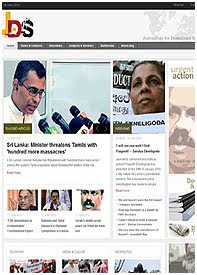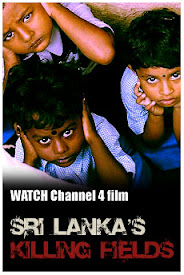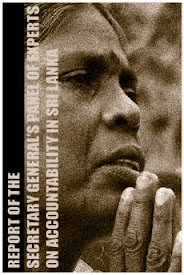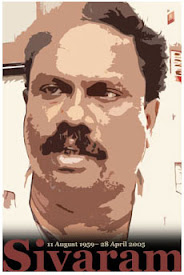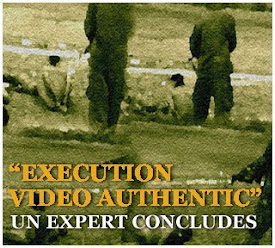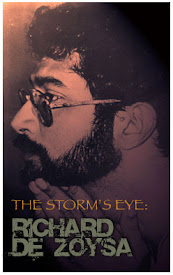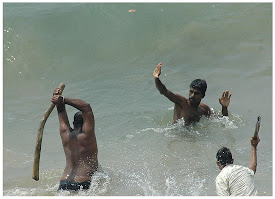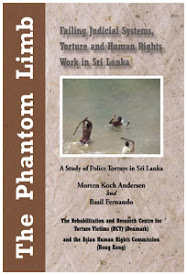
By Amantha Perera | Inter Press Service
.............................................................................................................................................................................................
And it continued till Chanaka, a worker from an industrial park, was laid to rest three days later, giving the funeral the appearance of a military drill. The heavy military presence was a message the government was not going to let the funeral become a vehicle for further demonstrations.
On May 30, Chanaka had joined a protest against a proposed private sector pension scheme at the Katunayake Free Trade Zone (FTZ), about 30 km north of the capital Colombo, where he worked. But then police used excessive force and live bullets to quell the protest, fatally wounding Chanaka. More than 250 others, including over a dozen police officers, were injured.
On the day of his funeral, hours before the planned procession in the afternoon, the military removed Chanaka’s body from his father’s house and brought it to a small church nearby. The villagers protested, but the body was kept at the church for over five hours.
As the military laid out a heavy dragnet, armed soldiers stood beside the entrance and lined the short path the funeral procession took. Only relatives were allowed to remain inside the church. Everyone else, thousands of them, had to walk single file, pay their respects and move out.
"It was as if the government wanted to make sure it had control of the entire funeral," said one mourner who did not wish to be identified.
With such diligent attention to the security detail, the government made sure that the funeral did not get out of hand, and the workers’ anger was not further inflamed.
The protests that Chanaka had joined were the first such public venting of displeasure under the government of President Mahinda Rajapaksa, who has ridden on a wave of popularity after ending a two-and-a-half-decade-old war in May 2009.
Rajapaksa moved quickly to withdraw the proposed bill, as the workers’ protests grew. The government also removed the police from the FTZ and handed over security to the military, which also withdrew from the zone ten days later.
For the protestors and union leaders, it was a bitter victory. "The workers know that they are safe for the time being," Anton Marcus, who heads the Free Trade Zone Workers’ Union (FTZWU), told IPS. "Their main fear was that with this proposed scheme, the gratuity and trust fund payments they get on retirement or on leaving a job would be lost," he said. The FTZWU has over 16,000 members from within and outside the trade zones.
The union leader, however, admitted that workers were still nervous about what to expect next, given the high-handed police action that cost a life, and the foreboding military presence right through the funeral.
The government has also not totally withdrawn the proposed bill, but merely suspended it, and not at the cabinet level but at a meeting of the central committee of the Sri Lanka Freedom Party, the largest partner in the ruling People’s Alliance Government.
The suspension of the bill was announced the same day as the violent protests in the FTZ. The government stated: "The proposed private pension scheme will be discussed with the trade unions, political parties and at the government's parliamentary group meeting."
Marcus told IPS that unions agreed in principle on a pension scheme for private sector employees. What they protested was the government’s failure to include in the proposed bill any input from unions or workers’ representatives.
"This was a rush job, the bill was just pushed through, there was no dialogue at all," the union leader said. He told IPS that any new proposal should be finalised after consultations with representatives of employees. A major grouse the employees have with the suspended bill was that there was no government contribution, a unanimous demand of the workers.
Political parties supporting the workers have also expressed the same sentiments: any new bill should be a consultative process. Opposition Leader Ranil Wickremasinghe observed that the government had erred by not taking on his recommendation for a consultative process for the suspended bill.
Tilvin Silva, general secretary of the People’s Liberation Front that has a large trade union base, said the party would support any proposed bill as long as workers’ rights were guaranteed.
Economists feel that if the government adopts high-handed tactics to dampen workers’ protests, it could lead to greater chaos. "This government cannot bulldoze the workers," Muttukrishna Sarvananthan, the head of the Point Pedro Development Institute, told IPS.
Any assault on FTZ workers also risks international fallout. "The violent crackdown on FTZ workers would negatively impact on the ongoing review of the Generalised System of Preferences (GSP) tariff concession given by the United States," Sarvananthan said.
Last year, Sri Lanka lost GSP facilities worth 100 million dollars a year to the European Union over what the Union said was the country’s failure to adhere to human rights standards. Though garment exports have rebounded from the EU action, Sarvananthan warned that similar action by the U.S. could be difficult to absorb.
While the Katunayake FTZ is the largest, Sri Lanka has 12 such zones where 265 companies are based and employ well above 100,000 workers, the bulk of them women. FTZ-based companies that enjoy tax holidays and other incentives accounted for eight percent of the country’s eight-billion-dollar exports in 2010.
© IPS
Saturday, June 11, 2011
Sri Lanka: A life lost in protest against Pension Bill
Saturday, June 11, 2011
Channel 4 tests boundaries of broadcasting with Sri Lanka exposé

By Ian Burrell - Media Editor | The Independent
.............................................................................................................................................................................................
The footage, much of it taken by the troops themselves on their mobile phones as war trophies at the end of the 2009 conflict with Tamil rebels, has been identified by the United Nations Special Rapporteur on Extrajudicial, Summary or Arbitrary Executions, Christof Heyns, as evidence of "definitive war crimes".
That will put pressure on the Secretary-General of the United Nations, Ban Ki-moon, to order an investigation into war crimes by Sri Lankan armed forces and Tamil Tiger fighters, which he has so far resisted.
The documentary, Sri Lanka's Killing Fields, shows the undressed bodies of bound Tamil women who appear to have been sexually abused being thrown on to trucks by laughing Sri Lankan soldiers. At one point in the film, one soldier tells his comrade: "Pose with the bodies!" The programme also contains footage shot by Tamil civilians on personal cameras and mobile phones showing systematic shelling of hospitals.
It contains testimony from UN officials, including Gordon Weiss, the UN spokesman on Sri Lanka, who alleges that there had been "roughly 65 attacks on medical points that were treating civilians". He says: "It probably constitutes a war crime." Vany Kumar, a British biomedical technician who was caught up in the fighting when visiting Tamil relatives and was under fire in the hospitals, gives witness evidence of the attacks.
In The Independent today, C4's most senior news executive defends the decision to broadcast the images but actually warns viewers against tuning in. Dorothy Byrne, head of news and current affairs, said: "I don't urge you to watch this programme. It's horrific. The images will remain in your mind, maybe for years."
Last week, the film was shown at the United Nations Human Rights Council in Geneva and watched by an audience that included the United States, the United Kingdom and Indian ambassadors to the UN. An early day motion has been tabled in Parliament by the Conservative MP Lee Scott, calling "on the UN to establish an independent, international mechanism to ensure truth, accountability and justice in Sri Lanka". It advises all MPs to watch the documentary, scheduled to be shown on Tuesday evening.
Ms Byrne says that the programme has been made so that the most harrowing imagery is shown well after the watershed to protect children. "But there are probably many adults who shouldn't watch; people who can't watch horrible stuff on the news," she said. "I would definitely say pregnant women shouldn't look at it. I would rather I had never seen it."
At the start of the programme, C4 presenter Jon Snow issues a warning to the audience: "This film contains very disturbing images depicting death, injury, execution and evidence of sexual abuse and murder, much of it filmed on mobile phones or small cameras." Last night he told The Independent that the film was "the most important I have ever reported". He said: "I have reported civil wars before, not least in Central America in the 1980s but I have never seen such graphic evidence, often at the hands of government soldiers themselves, of what have all the hallmarks of war crimes."
Sam Zafiri, Amnesty International's director for Asia Pacific, said he hoped that the broadcasting of the new evidence would ensure that there was no cover-up of the atrocities. "The Sri Lanka government really tried very hard to make sure this was a war without any independent witnesses," he said. The programme also contains footage of atrocities committed by Tamil Tiger rebels against civilians.
Channel 4 first showed images of Sri Lankan troops committing alleged summary executions in 2009, soon after the end of the war. The Sri Lanka government accused the broadcaster of fabricating that footage.
In a statement issued to Channel 4, it also rejected the new evidence of atrocities and claimed that the broadcaster failed to meet "the 'standards and fairness' expected of a responsible TV channel".
The 26-year struggle
After 26 years of fighting for an independent homeland, the Liberation Tigers of Tamil Eelam (LTTE) were crushed in a government offensive that ended in May 2009. A UN report found that tens of thousands of people died during the final months of ferocious fighting. The UN panel in April found that government troops repeatedly shelled so-called "no-fire zones" where they had encouraged civilians to gather. Some hospitals in the zones were repeatedly hit. The LTTE also committed atrocities. The government of President Mahinda Rajapaksa dismissed the panel's findings. Mr Rajapaksa was swept back to power at elections in 2010.
© The Independent
Saturday, June 11, 2011
Garments are major Sri Lankan exports to UK
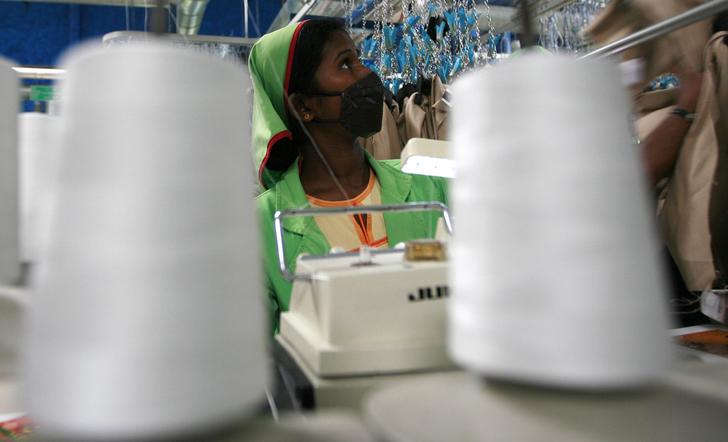
Fibre2fashion
.............................................................................................................................................................................................
In 2009, garment sector accounted for a larger part of the over US$ 1 billion Sri Lankan exports to the UK. In 2010, the UK was the second largest FDI investor in Sri Lanka.
Coats is the biggest manufacturer of thread in the world. The company has a long presence on the island, following best practices and even driving innovations within its operations. The company has recently signed a deal to work with the Sri Lanka Design Festival, as a part of its support to the fashion and craft industry in Sri Lanka.
Quantum Clothing, on the other hand, is a company that exclusively exports its products to Marks and Spencer. Initially, the company commenced its operations in Sri Lanka as a part of Coats Lanka. Producing an output of approximately 300,000 items per week, the company currently provides job to 1,800 people.
Coats Lanka supplies Quantum Clothing with some of its requirements for clothing, which is, in turn, directly exported to the UK.
The High Commissioner said that his visit would help in understanding the Sri Lankan garment sector’s exports to the UK. It would help increase the foreign direct investment (FDI) from the UK to Sri Lanka.
Giles Watkins, Managing Director of Coats Thread Exports, said that a few of the company’s latest innovations in thread have been invented in Sri Lanka. He lauded Sri Lanka as a good hiring market due to its highly skilled workforce.
Yohan Lawrence, Country Manager of Quantum Clothing Lanka, echoed similar views. He explained that his company also has production units in Cambodia and India, where production costs are lower than Sri Lanka, however, due to its better skilled force, Sri Lanka is a priority for the company, especially when supplying to popular apparel brands.
© Fiber2Fashion
Saturday, June 11, 2011
Tamil Nadu Assembly seeks economic sanctions against Lanka

By Express News Service | Indian Express
.............................................................................................................................................................................................
Speaking on the resolution that she moved, the Chief Minister also used the opportunity to unleash an attack on the previous DMK regime headed by M Karunanidhi, criticising it for staging “dramas” instead of taking efforts to actually working to save the lives of the Lankan Tamils who eventually succumbed to the shells and bullets of the army there.
The resolution charged the Sri Lankan government with indiscriminate shelling even on hospitals and habitations. “The Sri Lankan government neither heeds to India or anyone else when it comes to the basic rights of Tamils. Economic sanction is the only way we can force the government there to ensure that the Tamils, who are now locked inside the government-run refugee camps, will have a life of pride, dignity and equality,” said Jaya during the discussion on the resolution.
© Indian Express
This site is best viewed with firefox

Search
Is this evidence of 'war crimes' in Sri Lanka?
Archive
- ► 2010 (1312)
- ▼ 2011 (687)
Links
- Reporters Sans Frontières
- Media Legal Defence Initiative
- International Press Institute
- International News Safety Institute
- International Media Support
- International Freedom of Expression eXchange
- International Federation of Journalists
- Committee to Protect Journalists
- Asian Human Rights Commission
- Amnesty International
